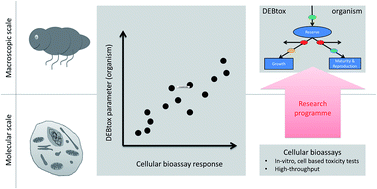当前位置:
X-MOL 学术
›
Environ. Sci.: Processes Impacts
›
论文详情
Our official English website, www.x-mol.net, welcomes your
feedback! (Note: you will need to create a separate account there.)
Physiological modes of action across species and toxicants: the key to predictive ecotoxicology†
Environmental Science: Processes & Impacts ( IF 4.3 ) Pub Date : 2017-11-01 00:00:00 , DOI: 10.1039/c7em00328e Roman Ashauer 1, 2, 3, 4, 5 , Tjalling Jager 6, 7, 8
Environmental Science: Processes & Impacts ( IF 4.3 ) Pub Date : 2017-11-01 00:00:00 , DOI: 10.1039/c7em00328e Roman Ashauer 1, 2, 3, 4, 5 , Tjalling Jager 6, 7, 8
Affiliation

|
As ecotoxicologists we strive for a better understanding of how chemicals affect our environment. Humanity needs tools to identify those combinations of man-made chemicals and organisms most likely to cause problems. In other words: which of the millions of species are at risk from pollution? And which of the tens of thousands of chemicals contribute most to the risk? We identified our poor knowledge on physiological modes of action (how a chemical affects the energy allocation in an organism), and how they vary across species and toxicants, as a major knowledge gap. We also find that the key to predictive ecotoxicology is the systematic, rigorous characterization of physiological modes of action because that will enable more powerful in vitro to in vivo toxicity extrapolation and in silico ecotoxicology. In the near future, we expect a step change in our ability to study physiological modes of action by improved, and partially automated, experimental methods. Once we have populated the matrix of species and toxicants with sufficient physiological mode of action data we can look for patterns, and from those patterns infer general rules, theory and models.
中文翻译:

跨物种和有毒物的生理作用方式:预测性生态毒理学的关键†
作为生态毒理学家,我们致力于更好地了解化学物质如何影响我们的环境。人类需要工具来识别那些最有可能引起问题的人造化学物质和有机物的组合。换句话说:数百万种物种中有哪些受到污染的风险?在成千上万种化学药品中,哪一种对风险的影响最大?我们发现我们对生理作用模式(化学物质如何影响生物体中的能量分配)以及它们在物种和有毒物质之间如何变化的了解不足,这是一个主要的知识缺口。我们还发现,预测性生态毒理学的关键是对生理作用模式进行系统,严格的表征,因为这将使更强大的体外至体内毒性外推和在计算机生态毒理学中。在不久的将来,我们期望通过改进的,部分自动化的实验方法,研究生理作用方式的能力将发生重大变化。一旦我们用足够的生理作用模式数据填充了物种和有毒物质的矩阵,我们就可以寻找模式,并从这些模式中推断出一般规则,理论和模型。
更新日期:2017-11-01
中文翻译:

跨物种和有毒物的生理作用方式:预测性生态毒理学的关键†
作为生态毒理学家,我们致力于更好地了解化学物质如何影响我们的环境。人类需要工具来识别那些最有可能引起问题的人造化学物质和有机物的组合。换句话说:数百万种物种中有哪些受到污染的风险?在成千上万种化学药品中,哪一种对风险的影响最大?我们发现我们对生理作用模式(化学物质如何影响生物体中的能量分配)以及它们在物种和有毒物质之间如何变化的了解不足,这是一个主要的知识缺口。我们还发现,预测性生态毒理学的关键是对生理作用模式进行系统,严格的表征,因为这将使更强大的体外至体内毒性外推和在计算机生态毒理学中。在不久的将来,我们期望通过改进的,部分自动化的实验方法,研究生理作用方式的能力将发生重大变化。一旦我们用足够的生理作用模式数据填充了物种和有毒物质的矩阵,我们就可以寻找模式,并从这些模式中推断出一般规则,理论和模型。











































 京公网安备 11010802027423号
京公网安备 11010802027423号